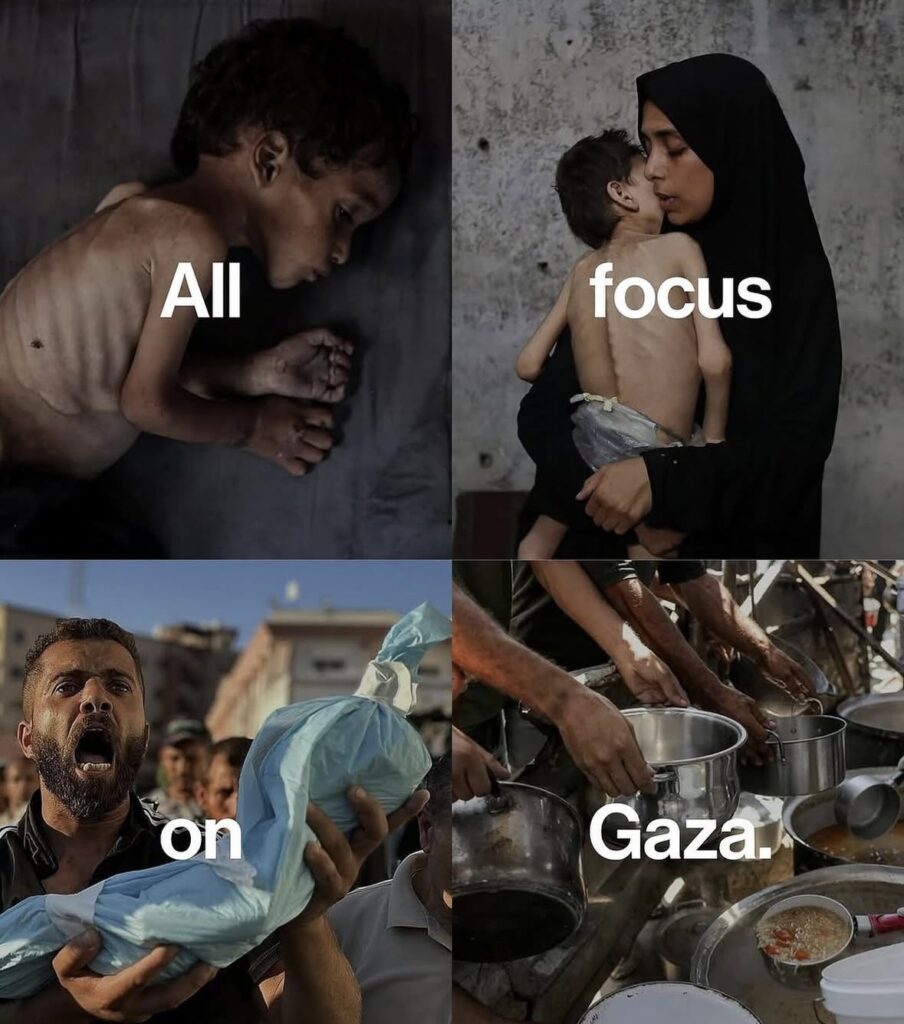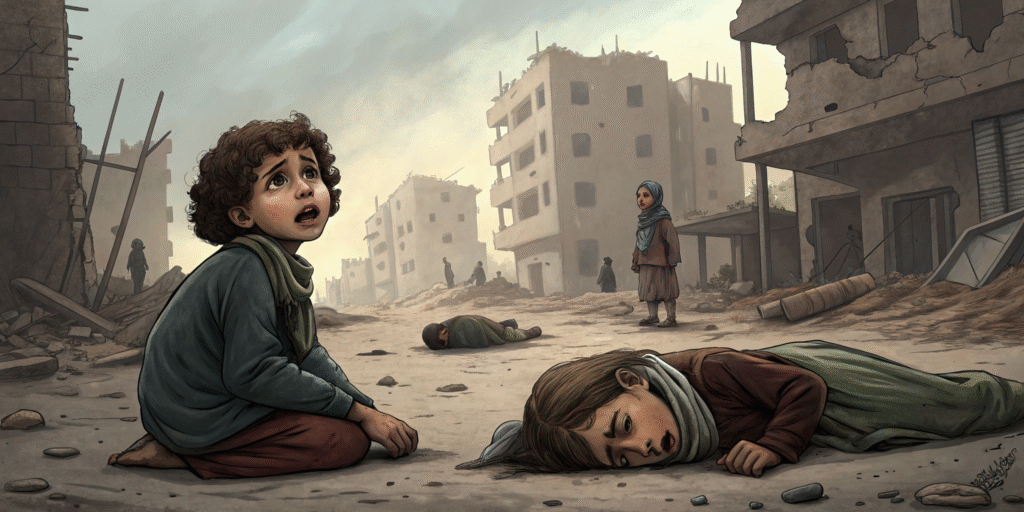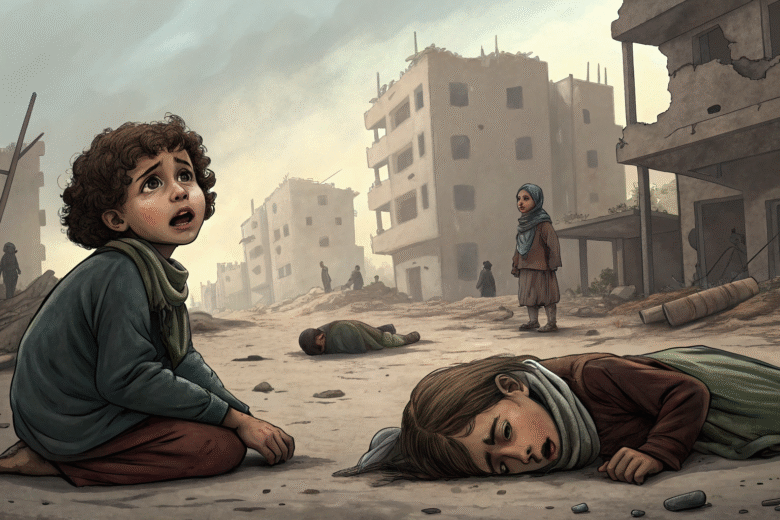Category: Human Rights | War Crimes | Middle East
Tags: Gaza children, blockade, malnutrition, UNICEF, OCHA, WHO, Save the Children
Publish date: August 16, 2025

Summary
Gaza’s children have endured 18 years of blockade and two years of all-out war, with mass killing, starvation, and psychological devastation documented by UN agencies and NGOs. Recent UN briefings warn of rising child deaths from acute malnutrition and a generation facing “relentless mental harm.” This article compiles the latest figures, survivor context, and a timeline from 2007–2025. unicef.orgAP Newswho.intSave the Children International
Lead
Gaza has become the most dangerous place in the world to be a child. Since October 2023, large-scale bombardment, siege, and access restrictions have killed and injured tens of thousands of children and plunged hundreds of thousands more into hunger and trauma, according to UN and humanitarian organizations. UNICEF leadership returned from Gaza in late July 2025 with an urgent warning: the crisis for children is acute, escalating, and preventable. unicef.org
Children Killed, Starved, and Terrified
- Escalating hunger and child deaths. UN and medical reporting from July–August 2025 describe daily arrivals of severely malnourished children at Gaza hospitals and an increase in famine-related child fatalities. WHO reported that 63 out of 74 malnutrition-related deaths in 2025 occurred in July, including at least 24 children under five. AP correspondents witnessed pediatric wards overwhelmed as families arrive too late to save toddlers wasted by months without adequate food or care. who.intAP News
- Mass casualty events hitting children. UNICEF’s Executive Director condemned strikes on makeshift shelters on March 18, 2025, noting one of the largest single-day child death tolls of the war. The agency stressed that “nowhere is safe” for children in Gaza. unicef.org
- Mental health collapse. After months of bombardment layered on years of closure, Save the Children describes “relentless mental harm” and the near “complete psychological destruction” of Gaza’s children—who increasingly cannot imagine a future. The group documents pervasive nightmares, anxiety, and regression among young children. Save the Children International
- Explosive injuries and lifelong disability. In 2024 alone, the use of explosive weapons left an average of 15 children a day with potentially life-changing injuries, including amputations and burns, according to Save the Children. Save the Children UK
Bottom line: UN agencies call these child deaths and traumas preventable—the result of policy choices that restrict aid, food, fuel, and medical evacuations amid ongoing military operations. who.int
Survivor Reality
Parents describe carrying skeletal toddlers across rubble and checkpoints for hours to reach the few operating clinics. Aid workers recount children too weak to cry, and school-age kids who flinch at any loud sound, unable to sleep through the night. These first-person accounts echo documented patterns from Save the Children’s fieldwork and UN briefings. Save the Children Internationalunicef.org
Why So Many Children Are Dying
- Siege & access restrictions. Prolonged restrictions on food, fuel, medicine, and medical evacuation—compounded by damaged roads and active hostilities—have produced acute malnutrition and delayed treatment for otherwise survivable illnesses and injuries. OCHA’s weekly situation updates note persistent treatment gaps and tens of thousands still awaiting urgent evacuation. ochaopt.org
- Attacks on densely populated areas & shelters. Repeated strikes on residential zones and displacement sites have generated mass-casualty incidents; UNICEF called the March 18 attacks “beyond horrifying,” emphasizing the extraordinary toll on children. unicef.org
- Health system collapse. With hospitals damaged and supply chains shattered, many children arrive too late or cannot be stabilized, as frontline reporting from AP in July–August 2025 attests. AP News

Timeline: From Blockade (2007) to Catastrophe (2025)
- 2007–2014: Comprehensive blockade begins; movement of people and goods severely curtailed. Recurrent escalations devastate civilian infrastructure; Egypt’s Rafah crossing opens intermittently and for long periods remains restricted. unicef.orgOxfam International
- 2015–2021: Chronic shortages and unemployment entrench child poverty and malnutrition; mental-health burden grows under prolonged closure. (UNICEF/UNRWA situation reporting.) unicef.orgunrwa.org
- 2022: UNICEF details the humanitarian impact of 15 years of blockade, highlighting constrained exits and fragile services for children. unicef.org
- Oct 2023–2024: Full-scale war; mass displacement; repeated strikes on homes, schools, and medical facilities; child casualties surge; explosive weapons leave hundreds of children monthly with life-altering injuries. Save the Children UK
- Mar 18, 2025: One of the deadliest days for children—UNICEF decries attacks hitting shelters with families and sleeping children. unicef.org
- Jul–Aug 2025: UN and WHO warn of surging malnutrition deaths, especially in children under five; hospitals report daily inflows of starving children. who.intAP News
What International Law Says
Humanitarian law prohibits starvation of civilians as a method of warfare and obligates parties to facilitate rapid and unimpeded humanitarian relief. Rights groups and UN officials have long criticized the blockade and current access restrictions as collective punishment—illegal under the Fourth Geneva Convention. Wikipedia
What Must Happen Now (policy brief)
- Immediate, safe humanitarian access—food, fuel, medical supplies, and functioning corridors to all areas. (UN/WHO) who.int
- Mass medical evacuations for children with complicated injuries and severe acute malnutrition, not just ad-hoc approvals. (OCHA) ochaopt.org
- Protection of civilians and civilian objects—including schools, hospitals, and shelters—consistent with IHL and repeated UNICEF appeals. unicef.org
- Child-focused recovery: trauma care, education catch-up, family tracing, and disability support as demanded by child-rights agencies. (Save the Children/UNICEF) Save the Children International
Sources & Further Reading
- UNICEF — Gaza emergency briefings & statements (Aug 1 and Mar 18, 2025). unicef.org+1
- WHO — Malnutrition and hunger-related deaths update (July 27, 2025). who.int
- OCHA oPt — Humanitarian Situation Update #311; evacuations and unmet needs (Aug 2025). ochaopt.org
- Save the Children — Psychological harm (Mar 2024) and injury analysis (Jan 2025). Save the Children InternationalSave the Children UK
- AP — Hospital reports of daily arrivals of severely malnourished children (Aug 2025). AP News
- Context on the blockade — UNICEF/UNRWA/Oxfam backgrounders; legality debates. unicef.orgunrwa.orgOxfam InternationalWikipedia

